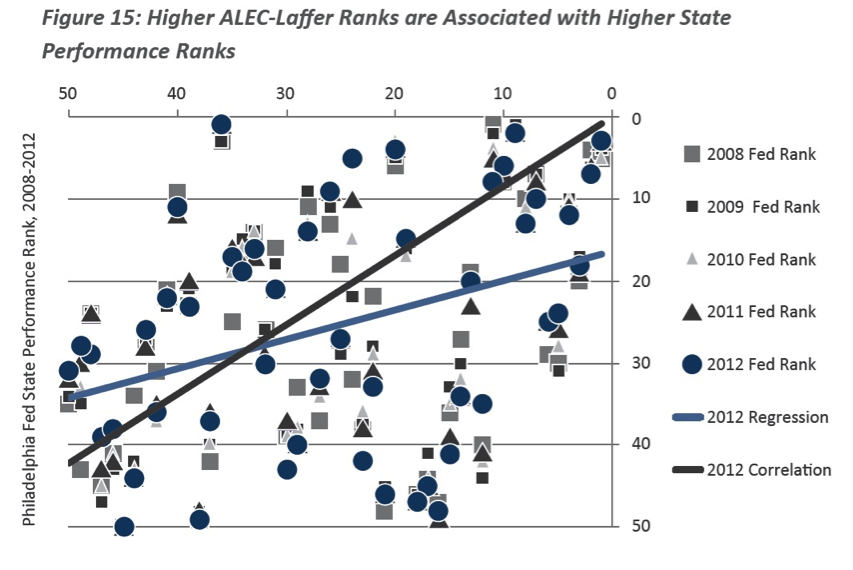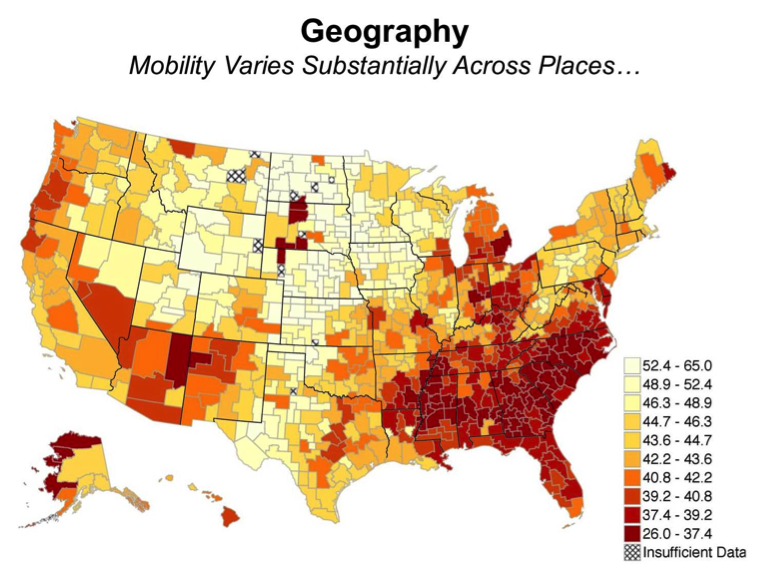How We Should Think About Income Inequality
Later today President Obama will deliver the annual State of the Union address. By most indications, the speech will focus on income inequality, an issue the President has previously called “the defining issue of our time.” His speech comes on the heels of the release of important new research published on income mobility last week, showing that U.S. income mobility hasn’t changed in nearly 50 years. Given this, it is worth taking pause to separate fact from myth on inequality, and consider what is concerning about inequality and what is not. Too often, discussions of inequality misidentify the actual problems and ignore the clear solutions. In short, America should focus on opportunity and not equality (i.e. income mobility), and fix the structural issues that inhibit mobility by embracing policies known to foster income growth and job creation.
Mismeasuring Inequality
We have detailed previously some of the key issues with inequality data in an American Legislator blog post, along with issues associated with income inequality’s paired claim: median income stagnation. Both posts are based on our recent publication, Tax Myths Debunked, which takes on seven often-repeated myths about tax and fiscal policy. Both posts conclude that inequality and wage stagnation are largely overstated.
One part of the error in standard accounts of growing income inequality and median wage stagnation is measurement. The Manhattan Institute’s Scott Winship gives a good rundown of some of the issues in his recent testimony to Congress’s Joint Economic Committee. Many of them are technical and involve the difference between “household” vs. “tax filer” inequality, long-term shifts in the composition of households, and what income should be included in income inequality and what shouldn’t (pass-through business income, capital gains, etc.).
Other issues are far less technical. For one, standard inequality and median wage measures look at income inequality but not consumption inequality, ignoring changes in prices and quality of goods that are relevant to standard of living concerns. For example, as two recent Learn Liberty videos have pointed out (both can be found embedded in this post), what should be considered the number of hours of work needed to achieve a given lifestyle for the median worker, whether that standard of living is increasing, and if the growing gap in quality of life between income groups is actually increasing.
Another measurement issue considers whether to include the effect of government transfer payments and taxes in measurements of inequality and median wages. After all, if one is arguing based on perceived growing inequality that the government either needs to pay out more benefits to middle and lower income Americans, or tax the rich at a higher progressive income tax rate, shouldn’t one at least know whether inequality is actually increasing after the taxation and redistribution that’s already occurring? Thus, the effect of taxes and benefits received must be included in both median wage and income inequality measures to give an appropriate income picture of America. It rarely is.
Once these issues are properly accounted for, we see measured inequality fall to near zero or even slightly negative. Moreover, we see that median wage stagnation is similarly overstated. The before mentioned Joint Economic Committee testimony by Scott Winship, relying heavily on the work of Cornell University economist Richard Burkhauser (who is also cited extensively in ALEC’s Tax Myths Debunked), covers these issues and figures in great detail.
“Thinking Clearly About Economic Inequality”
Setting aside measurement issues with inequality, there are some big conceptual issues in thinking about inequality, and any call for government action requires connecting a statistic to some sort of social ill or injustice. Will Wilkinson, in a paper for the Cato Institute titled “Thinking Clearly About Economic Inequality,” sets out a clear blueprint for how inequality should be considered in terms of public policy.
There are two key ways inequality matters and should be considered seriously. One is if inequality is the outcome of some injustice in our society. Take corporate cronyism: the dynamic by which big business or powerful individuals are enriched by government policy that benefits the few powerful but is not in the interest of the nation as a whole. To the extent that accumulation of income in the top 1 percent is the process of cronyism, said income accumulation should be taken quite seriously (see Timothy P. Carney and David Schmidtz). Those unjust policies should be eliminated, though not on ground of inequality: on grounds of injustice. Thus, inequality is just a metric by which injustice is potentially (but necessary) detected.
The other is when inequality is the result of poor prospects for opportunity among middle and low income Americans. To the extent that inequality is the result of stagnant or falling wages, or slow job creation, we should take inequality as a sign that something is not well in our policy environment. But here again, we should strike at the root cause: poor opportunity, also known as “income mobility.” Income mobility is the measure of how likely children born into lower income groups are to make it into higher income groups than their parents as they grow up.
What should not be considered alarming is the gap in wealth, in and of itself. Inequality does not possess an inherent moral or economic challenge. Inequality is but one measure and shouldn’t overshadow more important measures of the health of an economy: income mobility, job creation, median wage growth, entrepreneurship, and economic growth.
Income Mobility & Economic Growth
It’s here that we come to a recent study by the Harvard Equality of Opportunity project on income mobility. The study details that mobility has been stable for nearly 50 years, neither rising nor falling. This is in stark contrast to conventional wisdom, which was that income mobility had declined substantially, along with increasing income inequality. Moreover, counter the claims of many (i.e. the so-called “Great Gatsby Curve”), the evidence that income mobility and inequality have any firm relationship is exceedingly weak. And as Scott Winship’s before-mentioned testimony points out, the evidence is mixed or weak that income inequality hampers economic growth of a nation or that income concentration at the top 1 percent comes at the expense of income growth among other income groups. Even liberal economist Paul Krugman is on record, notwithstanding his grave concerns about income inequality, saying that income inequality does not appear to harm economic growth.
The take-away here is that not only does income inequality growth and median wage stagnation appear to be overstated, but the evidence that it harms economic fundamentals (income mobility, income growth, job creation, economic growth, etc.), appears to be weak. The notion that the United States is in the midst of a new Gilded Age appears to be unsubstantiated.
Still, problems exist in our society, even if those problems are not caused by inequality. Economic growth, job creation, and median wage growth are exceedingly weak (particularly for Millennials) in the midst of the United States’ anemic recovery. And mobility is still far too low and uneven across our nation. Less than 10 percent of the children born to the bottom 20 percent of income earners will make it into the top 20 percent of income earners later in life. 70 percent of poor children will fail to make it into the middle class. This map, from the Equality of Opportunity project, shows the country-by-county income mobility results and indeed, they are uneven:
The Path Forward
Rather than focusing on inequality, America, the President, the U.S. Congress, and state policymakers should turn their attention to the economic fundamentals of America. Rather than shifting the size of the slices going to different groups of the economic pie, the emphasis should be on growing the pie. America can and should do better in terms of income mobility, and policies that boost job growth and income growth are the remedy to an underperforming American economy.
Consider the recent research of Dr. Eric Fruits, one of the authors of ALEC’s Tax Myths Debunked. This chart from Dr. Fruits shows that the most unequal states tend to be the states with the worst job creation performance:
 Rather than investing in great levels of redistribution and progressive taxation to reshuffle the proverbial income distribution deck, the federal government and 50 state governments should embrace pro-growth policies that emphasize work, innovation, savings, new business start-ups, and business expansion. High progressive taxes, while seemingly a quick fix to income inequality, harm income mobility by lowering job creation and income growth. And moreover, redistribution that does not properly limit total fiscal cost or creates disincentives to work leads to economic stagnation, not economic growth. Government safety nets should focus on getting people back to work and not existing as a hammock that perpetuates poverty.
Rather than investing in great levels of redistribution and progressive taxation to reshuffle the proverbial income distribution deck, the federal government and 50 state governments should embrace pro-growth policies that emphasize work, innovation, savings, new business start-ups, and business expansion. High progressive taxes, while seemingly a quick fix to income inequality, harm income mobility by lowering job creation and income growth. And moreover, redistribution that does not properly limit total fiscal cost or creates disincentives to work leads to economic stagnation, not economic growth. Government safety nets should focus on getting people back to work and not existing as a hammock that perpetuates poverty.
The path to more income mobility in America is complicated, and includes issues far beyond tax, fiscal, and regulatory policy. Certainly, there are deep issues with our current education system and many other areas of public policy that deeply disadvantage the poor. But state and federal policymakers should focus improving the economic climate as they also look to improve all areas of failing American public policy. Rich States, Poor States provides a guide to states in improving their economic policy, just as economic freedom indices by Cato-Fraser and Heritage-Wall Street Journal provide a path to the federal government. Statistical analysis conducted in Tax Myths Debunked shows that Rich States, Poor State’s Economic Outlook Index is strongly correlated with state economic health:
 Income inequality is not unimportant, but is too often a red herring that distract from other more pressing and primary public policy issues. Indeed, those primary public policy issues are often the cause of inequality, rather than being caused by economic inequality. Still, Americans are right to be unsatisfied with their nation and states’ economic performance. The nation and every single state can certainly do better and policymakers at every level owe it to their citizens to do better. The solution remains clear: improve the fundamentals of the American economy through economic freedom and sound, limited government.
Income inequality is not unimportant, but is too often a red herring that distract from other more pressing and primary public policy issues. Indeed, those primary public policy issues are often the cause of inequality, rather than being caused by economic inequality. Still, Americans are right to be unsatisfied with their nation and states’ economic performance. The nation and every single state can certainly do better and policymakers at every level owe it to their citizens to do better. The solution remains clear: improve the fundamentals of the American economy through economic freedom and sound, limited government.

